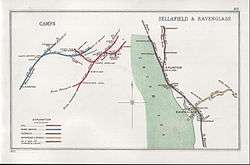Sellafield railway station
Sellafield railway station serves the nuclear facility of Sellafield in Cumbria, England. The station is owned by Network Rail and managed by Northern which provide all passenger services. The station is a stop on the scenic Cumbrian Coast Line, 11 1⁄2 miles (18.5 km) south of Whitehaven. Some through trains to the Furness Line towards Lancaster stop there.
| Sellafield | |
|---|---|
 | |
| Location | |
| Place | Sellafield |
| Local authority | Copeland |
| Coordinates | 54.417°N 3.510°W |
| Grid reference | NY020034 |
| Operations | |
| Station code | SEL |
| Managed by | Northern |
| Number of platforms | 2 |
| DfT category | F1 |
| Live arrivals/departures, station information and onward connections from National Rail Enquiries | |
| Annual rail passenger usage* | |
| 2014/15 | |
| 2015/16 | |
| 2016/17 | |
| 2017/18 | |
| 2018/19 | |
| – Interchange | 68 |
| History | |
| Key dates | Opened 1850 |
| National Rail – UK railway stations | |
| |
The station, which dates from 1850, is a busy freight location, because much of the nuclear waste for Sellafield's Thorp nuclear fuel reprocessing plant is carried there by train from the docks in Barrow-in-Furness, or from rail-connected nuclear power stations elsewhere in the UK. The facility also generates significant commuter traffic for the railway, with workers travelling by train from nearby towns & villages.[1]
The station is at the end of the single-line section from Whitehaven, which is operated using the electric key token system. From there, the line south towards Ravenglass and Barrow is double track, except for the final section between Park South Junction (south of Askam) and Barrow, which was reduced to a single track in the late 1980s.
The station configuration is unusual in that the southbound ('up' line) is bi-directional through the station and has platform faces on both sides.[2] However, only the eastern platform face is used, the other side being fenced off. This allows trains from the south to terminate and turn back without having to enter the single-line section to St Bees. The signal box controlling the layout is located at the north end of the station, whilst the exchange sidings for the plant, and the loco depot used by Direct Rail Services freight trains, are to the south. There are two water cranes at the station, one at each end.[3]
The station used to be the southern terminus of the former Whitehaven, Cleator and Egremont Railway line from Egremont, from August 1869 until the line's closure in March 1964.[4]

Facilities
The station is not staffed, but there is now a ticket machine in the main building for passengers to buy tickets prior to travel. There is a waiting room on the southbound platform and a shelter on the opposite side; the rest of the main buildings are in private commercial use. The platforms are linked by a footbridge which does not include ramps, so only the Barrow platform has step-free access.[5] Train running information is provided by digital information screens, timetable posters and telephone.
Services
Northern Trains Route 6: Cumbrian Coast & Windermere Lines | ||||||||||||||||||||||||||||||||||||||||||||||||||||||||||||||||||||||||||||||||||||||||||||||||||||||||||||||||||||||||||||||||||||||||||||||||||||||||||||||||||||||||||||||||||||||||||||||||||||||||||||||||||||||||||||||||||||||||||||||||||||||||||||||||||||||||||||||||||||||||||||||||||||||||||||||||||||
|---|---|---|---|---|---|---|---|---|---|---|---|---|---|---|---|---|---|---|---|---|---|---|---|---|---|---|---|---|---|---|---|---|---|---|---|---|---|---|---|---|---|---|---|---|---|---|---|---|---|---|---|---|---|---|---|---|---|---|---|---|---|---|---|---|---|---|---|---|---|---|---|---|---|---|---|---|---|---|---|---|---|---|---|---|---|---|---|---|---|---|---|---|---|---|---|---|---|---|---|---|---|---|---|---|---|---|---|---|---|---|---|---|---|---|---|---|---|---|---|---|---|---|---|---|---|---|---|---|---|---|---|---|---|---|---|---|---|---|---|---|---|---|---|---|---|---|---|---|---|---|---|---|---|---|---|---|---|---|---|---|---|---|---|---|---|---|---|---|---|---|---|---|---|---|---|---|---|---|---|---|---|---|---|---|---|---|---|---|---|---|---|---|---|---|---|---|---|---|---|---|---|---|---|---|---|---|---|---|---|---|---|---|---|---|---|---|---|---|---|---|---|---|---|---|---|---|---|---|---|---|---|---|---|---|---|---|---|---|---|---|---|---|---|---|---|---|---|---|---|---|---|---|---|---|---|---|---|---|---|---|---|---|---|---|---|---|---|---|---|---|---|---|---|---|---|---|---|---|---|---|---|---|---|---|---|---|---|---|---|---|---|---|---|---|---|---|---|---|---|---|---|---|---|---|---|---|---|---|
| ||||||||||||||||||||||||||||||||||||||||||||||||||||||||||||||||||||||||||||||||||||||||||||||||||||||||||||||||||||||||||||||||||||||||||||||||||||||||||||||||||||||||||||||||||||||||||||||||||||||||||||||||||||||||||||||||||||||||||||||||||||||||||||||||||||||||||||||||||||||||||||||||||||||||||||||||||||
Bootle, Braystones, Drigg, Flimby, Green Road, Kirkby-in-Furness, Nethertown, Parton and Silecroft are request stops. | ||||||||||||||||||||||||||||||||||||||||||||||||||||||||||||||||||||||||||||||||||||||||||||||||||||||||||||||||||||||||||||||||||||||||||||||||||||||||||||||||||||||||||||||||||||||||||||||||||||||||||||||||||||||||||||||||||||||||||||||||||||||||||||||||||||||||||||||||||||||||||||||||||||||||||||||||||||
There is a basic hourly service (with a few variations) in each direction.[6] Certain southbound trains continue to Lancaster, and one service from the south terminates and turns back at Sellafield on weekdays only. Since the summer 2018 timetable came into effect on 20 May, trains operate later into the evening than previously and also on Sundays, the latter provision being the first since May 1976.
It was reported in November 2011 that Direct Rail Services (DRS) had applied to the Office of Rail Regulation to operate one train in each direction between Carlisle and Sellafield to carry workers to Sellafield.[7] Between May 2015 and December 2018, four trains per day each way ran to provide additional seating capacity for workers at the Sellafield plant, using Mark 2 coaches and Class 37 diesel locomotives hired in from DRS.
References
- "Places to Visit - Sellafield"Cumbrian Coast Line website; Retrieved 14 November 2016
- Sellafield station, looking south Thompson, Nigel Geograph.org; Retrieved 2 December 2016
- Sellafield Station Old Cumbria Gazetteer; Retrieved 2 December 2016
- Marshall, J (1981) Forgotten Railways North-West England, David & Charles (Publishers) Ltd, Newton Abbott. ISBN 0-7153-8003-6; p.163
- Sellafield station facilities National Rail Enquiries; Retrieved 2 December 2016
- Table 100 National Rail timetable, December 2019
- Clinnick, Richard (2 November 2011). "'Sellafield workers' trains will start this year' says DRS". RAIL (682): 6–7. ISSN 0953-4563.
External links
| Wikimedia Commons has media related to Sellafield railway station. |
- Train times and station information for Sellafield railway station from National Rail
| Preceding station | Following station | |||
|---|---|---|---|---|
| Northern Cumbrian Coast Line |